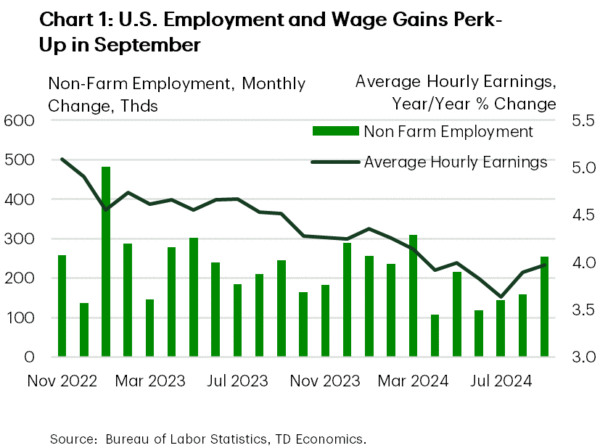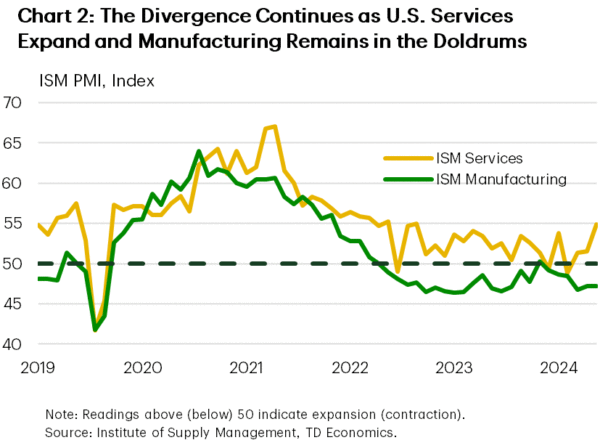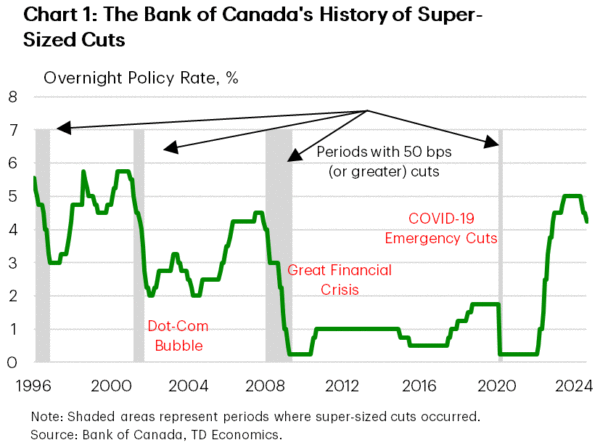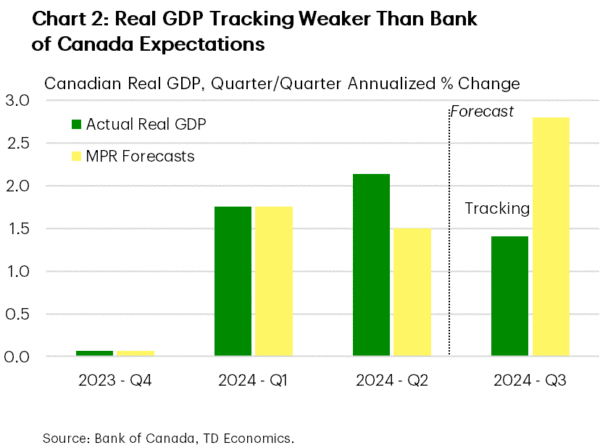U.S. Highlights
- The U.S. labor market perked up in September as job gains beat expectations, the unemployment rate ticked down and annual wage gains edged up.
- The economic outlook, however, has been buffeted by significant disruptions, namely Hurricane Helene and a port worker strike.
- The production side of the economy continues to travel two very different paths with manufacturing contracting, while services expand.
Canadian Highlights
- Canadian market conditions this week were dictated by U.S. and global developments amid a quiet domestic calendar.
- Markets are putting some odds on a larger 50 basis point cut at the Bank of Canada’s next rate announcement on October 23rd. We expect they will stick to a quarter point cut.
- The next two weeks will feature critical data releases including inflation, labour market updates and Bank of Canada surveys which will weigh heavily in the final decision.
U.S. – A Duo of Disruption Muddies the Economic Outlook
The labor market was the data highlight in a week rocked by a major strike and natural disaster. Ten-year bond yields were notably higher relative to yesterday’s close (0.11 basis points) and the S&P500 was also up about 0.4% as the strong jobs report tempered expectations about the Fed’s cutting cycle.
Today’s employment report revealed that while the labor market may be cooling, it is doing so at a moderate pace (see commentary). Payrolls gains handily surpassed expectations, the unemployment rate edged down slightly, and wage gains nudged higher (Chart 1). Overall, the report was better than many market participants had expected and complements the previously released JOLTS data for August. The JOLTS report showed that while firms have slowed the pace of hiring there still continues to be steady demand for workers, as the number of job openings rose slightly. After the superheated labor market witnessed earlier in the post-pandemic period, followed by a steady cooling, the current leveling off in demand and supply is in line with a labor market that is coming into better balance.
On the production side, the ISM Manufacturing Index was unchanged in September, remaining in contraction territory for the sixth consecutive month. On the services side, however, things were looking better, with the ISM Services Index rising notably in September. Overall, the services sector continues to hold its ground, offsetting much of the weakness evident in the country’s manufacturing sector (Chart 2).
In addition, a major dockworker strike at U.S. East and Gulf coast ports added to economic uncertainty. The strike was suspended late Thursday after the dockworkers’ union and the group representing ocean carriers reached an agreement to extend the currently expired contract, until January 15th. This allows dockworkers to resume work while negotiations over wages and port automation, which had been at an “impasse” for months, would now continue. While the worst effects of the strike have been avoided for now, the cloud of uncertainty continues to loom. If the two sides are not able to reach an agreement prior to the end of the extension, then things could be right back to where they were and the longer a strike persists, the greater the economic fallout.
The job market showing signs of only gradual cooling, lends support to Powell’s view expressed earlier in the week that officials didn’t see a reason to lower rates as aggressively as they did at their most recent meeting. Barring the uncertainty of recent events, the labor market remains key in the Fed’s assessment of the most appropriate policy action.
Canada – Taking Stock
This week served Canadian market watchers an opportunity to take a breather. There was no top-shelf economic data, no Bank of Canada (BoC) speeches, and no domestic headline-grabbing news. Beyond our borders however, a hefty U.S. jobs report pulled Canadian yields higher. The U.S. port strike also came to an end, stemming worries of potential near-term inflationary impacts. Elsewhere, conflict is escalating between Israel and Iran, which has sent oil prices almost 10% higher on the week to $74 per barrel. Despite the rise in oil prices, the Canadian dollar tracked modestly lower.
The BoC is 75 basis points (bps) into their cutting cycle, delivered in three 25 bps increments over their last three meetings. The pressing question for Macklem & Co. is whether they feel it’s necessary to deliver a supersized, 50 bps cut at their next meeting on October 23rd. Outside of the 2020 pandemic-emergency rate cuts, the ‘07–’08 Global Financial Crisis and the early-2000’s Dot-Com bubble, one would have to look back to Oct. 1996 to find the last time the BoC cut by more than the standard 25 bps in the middle of an easing-cycle (Chart 1).
With inflation now back to the two-percent target, the Bank is putting more stock into the growth outlook to ensure that inflation doesn’t fall too much. It’s a fair shift in priorities given the slowdown in the Canadian economy. Last week’s GDP reading for July, and advanced look-ahead for August, confirmed that third quarter growth is tracking well below both the BoC’s current estimate and potential growth (Chart 2). We don’t think the GDP data tipped the scales any more-or-less in favour of a potential 50 bps interest rate cut, which would follow the recent move from the Federal Reserve. The BoC also needs to accept that their current forecast is facing downside risk. A fresh set of forecasts via an updated Monetary Policy Report (MPR) at its next meeting will shed light on how they are looking at near-term growth.
Now, emphasis will be placed on upcoming inflation data and labour market trends, where the Bank will be assessing how durable the current 2% inflation is and whether or not labour markets are continuing to cool. The Business Outlook Survey (BOS) and companion consumer survey will also land next week and be closely watched.
With all we know to date, we look for the BoC to continue on their gradual path, delivering another 25 bps cut at their next meeting, bringing the policy rate to 4.00%. Market pricing, for what it’s worth, is attaching around a 30% chance of a supersized cut. We acknowledge the risk of a potential larger cut should incoming data display further signs of deterioration. Past this, we see rates continuing to gradually decline into next year before hitting 2.25% by early-2026.

















